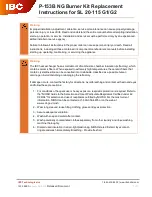
IBC Technologies Inc.
6
VFC 15-150 and VFC 45-225
d.
Place in operation the appliance
being inspected. Follow the lighting
instructions. Adjust thermostat so
appliance will operate continuously.
e.
After it has been determined that
each appliance remaining connected
to the common venting system
properly vents when tested as
outlined above, return doors,
windows, exhaust fans, fireplace
dampers and any other gas-burning
appliance to their previous
conditions of use.
f.
Any improper operation of the
common venting system should be
corrected so the installation
conforms with the National Fuel Gas
Code, ANSI Z223.1 - latest edition.
In Canada, all installations must
conform with the current CAN/CGA
- B149.1-05 Installation Code and/or
local codes.
When resizing any portion of the
common venting system, the common
venting system should be resized to
approach the minimum size as
determined using the appropriate tables
in the National Fuel Gas Code, ANSI
Z223.1 - latest edition. In Canada, use
the B149.1-05.Installation Code.
1.4.1 Applications
All VFC-series boilers are approved
with alternative venting options: either
2-pipe Direct Vent or single pipe /Indoor
Air venting can be used offering
flexibility to meet the specific
requirements of the installation. With the
Direct Vent case, combustion air is
piped directly to the boiler’s air intake
from outdoors. Using the indoor air
alternative, air for combustion is drawn
from the indoor air surrounding the
boiler.
Provided the maximum overall vent
length limit is not exceeded, the installer
may choose to vent the boiler through
the wall, directly through the roof or
upward using an existing - but otherwise
unused - chimney
as a vent raceway
(see
below).
It is a code requirement that the rating
plate reflect the boiler vent configuration
as installed.
To facilitate our venting
flexibility, VFC boilers are shipped
with the rating plate unmarked. The
installer shall indelibly mark the
appropriate box on the rating plate to
recognize the venting alternative
chosen.
1.4.1.1
Intake/Exhaust Vent Material
For the
exhaust
vent-
•
Canada:
commencing July 1, 2007
(with voluntary adoption before that
date), only PVC, CPVC or stainless steel
vent component systems approved under
ULC-S636
Standard for Type BH Gas
Venting Systems
are to be used. Certain
components specified for use under
these Instructions (and supplied by IBC
within the boiler vent kit, such as the 2”
threaded adaptor for connection with the
boiler outlet) had delayed availability in
ULC-S636
certified form; for these parts
alone, there is a grace period ending
June 30, 2008, permitting installation of
unmarked PVC (Sch.40 ASTM D1785
or D2665) and CPVC (ASTM F441
Sch.40 pipe and Sch.80 fittings).
Venting manufacturers, such as
IPEX
Inc
with their
System 636™
line,
establish exhaust temperature limitations
for their materials; it is the responsibility
of the installer to ensure that such
limitations are taken into account in the
selection of PVC vs. CPVC vs. stainless
steel systems. In the standard
configuration, VFC-series boilers can







































